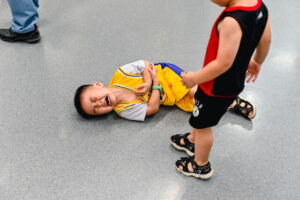
Table of Contents
Autism Spectrum Disorder (ASD) is a complex neurological condition that affects an individual or child’s ability to communicate, socialize, and perceive the world. While every person with autism is unique, some individuals may exhibit aggressive behaviors, such as hitting. This can be challenging for parents, caregivers, and educators, who are often left seeking answers and strategies to address these negative behaviors.
In this article, we will explore the reasons why individuals with autism may engage in hitting, as well as provide guidance and tools to help manage and reduce these behaviors.
Why Do Individuals with Autism Hit?
There are several reasons why a person with autism might engage in aggressive behavior, such as hitting. It’s essential to understand that these actions are not necessarily a reflection of the individual’s character but rather a means of communication or a response to overwhelming stimuli. Some common reasons for hitting in individuals with autism and aggressive behavior include:
Communication Difficulties
Many individuals with autism have difficulty with verbal and nonverbal communication, making it challenging for them to express their needs, wants, and emotions. In some cases, hitting may be an attempt to communicate frustration, anger, or discomfort when they cannot find the words or gestures to convey their feelings.
Sensory Overload
People with autism often have sensory sensitivities, which can make certain stimuli, such as loud noises, bright lights, or strong smells, overwhelming and distressing. Sensory overload can lead to feelings of anxiety and agitation, causing an individual dealing with autism to lash out physically as a way to cope with their discomfort.
Difficulty with Emotional Regulation
Emotional regulation refers to the ability to manage and respond appropriately to one’s emotions. Individuals with autism may have difficulty with emotional regulation, making it challenging for them to process and express their feelings in a socially acceptable manner. The child’s behavior can turn aggressive, such as hitting, when emotions become too intense to manage.
Lack of Social Understanding
Social norms and cues can be confusing and difficult to navigate for individuals with autism. They may not understand that hitting is an inappropriate behavior or may misinterpret the actions of others as threatening or hostile. In these cases, hitting may be a reaction to perceived social threats from peers or a misguided attempt to establish boundaries.
Four Functions of behaviors and autism
In order to effectively address an child’s aggressive behaviors, such as hitting, it is important to understand the four functions of behavior: Attention, Escape or Avoidance, Access to Tangible items or Activities, and Sensory Stimulation.
Attention: Hitting may be used in an attempt to gain attention from others. This could be positive attention from other children, such as praise or approval, or negative attention, such as scolding.
Escape or Avoidance: Hitting may be a way for the individual to escape or avoid an activity they find overwhelming, unpleasant, or uncomfortable.
Access to Tangible Items or Activities: In some cases, hitting may be used by an individual to gain access to something they want, such as a toy or food item.
Sensory Stimulation: Hitting may also be used to seek sensory input, such as hand flapping or jumping.
By understanding the function of hitting in the life of an individual with autism, it can help identify and implement strategies that address the behavior in a positive and proactive manner.
Strategies for Managing and Reducing Hitting Behaviors
While it can be distressing and challenging to manage aggressive behaviors of kids, such as hitting, there are several strategies and tools that parents, caregivers, and educators can employ to help reduce and address these behaviors:
Identify Triggers and Patterns
The first step in addressing hitting behaviors is to identify the factors that may be triggering or contributing to the aggression. This may involve observing the individual or child with autism closely, taking note of any patterns or commonalities in the situations that precede the hitting. By understanding the triggers, you can work to minimize or eliminate them, reducing the likelihood of aggressive outbursts.
Create a Safe Environment
Creating a safe and supportive environment can help individuals with autism feel more secure and less likely to engage in aggressive behaviors. This may involve providing a predictable routine, minimizing exposure to sensory triggers, and ensuring that the individual has access to comforting items or activities.
Teach Communication Skills
Helping individuals with autism develop their communication skills can empower them to express their needs, wants, and emotions more effectively, reducing the need for aggressive behaviors as a form of communication. This may involve teaching children alternative methods of communication, such as sign language, picture exchange systems, or augmentative and alternative communication (AAC) devices.
Encourage Emotional Regulation
Teaching individuals with autism strategies for managing their emotions can help reduce the likelihood of aggressive outbursts. This may involve providing tools for self-soothing, such as deep breathing exercises, fidget toys, or calming music, as well as explicitly teaching and modeling appropriate ways to express emotions.
Social Skills Training
Social skills training can help individuals with autism better understand social norms and cues, reducing the likelihood of hitting as a response to perceived social threats or misunderstandings. This may involve role-playing various social scenarios, discussing appropriate behaviors, and providing feedback and reinforcement for positive social interactions.
Reinforce Positive Behaviors
Reinforcing positive behaviors can help individuals with autism learn that there are more effective and socially appropriate ways to communicate and cope with their emotions. This may involve providing praise, rewards, or other forms of reinforcement when the individual engages in positive behaviors, such as using their words or seeking comfort from a parent or a caregiver.
Seek Professional Support
In some cases, professional support may be necessary to help address aggressive behaviors in individuals with autism effectively. This could involve working with a behavioral therapist, occupational therapist, or psychologist who has experience with children with autism and can provide tailored guidance and interventions.
How ABA therapy can help children with autism
Applied behavior analysis (ABA) is a type of therapy that focuses on teaching and reinforcing positive behaviors in individuals with autism. ABA can help reduce aggression, such as hitting and increase social skills, communication, adaptive behavior, and independence in children with autism. ABA approaches typically involve breaking down tasks into smaller pieces to make them easier for the individual to learn and understand, as well as providing positive reinforcement for engaging in desired behaviors.
ABA can be an effective tool for teaching children with autism how to manage their emotions and interact appropriately with others. It can also help them develop skills such as self-awareness, problem-solving, communication, decision-making, and participating in daily activities. For example, with ABA therapy, a child may learn how to request items or activities they want in an appropriate manner instead of hitting to get attention or gain access.
Applied behavior analysis is also flexible and can be tailored to the individual’s unique needs and preferences. Therapists are able to assess an individual’s strengths and weaknesses and design an appropriate program that meets their specific needs.
Overall, ABA can be a powerful tool for helping individuals with autism manage their behaviors and improve their quality of life. With the help of a trained professional, it can be used to effectively address aggressive behaviors such as hitting while teaching children with autism the skills they need to lead happy and fulfilling lives.
Conclusion
Hitting and other aggressive behaviors can be challenging for individuals with autism, as well as their families and caregivers. By understanding the underlying reasons for these behaviors and employing targeted strategies and tools, it is possible to manage and reduce aggression, helping individuals with autism lead happier, more fulfilling lives. Remember that each person with autism is unique, and it may take time and patience to find the most effective strategies for addressing hitting behaviors.
- Autism Routine Disruption in Adults: Coping Tips - July 16, 2024
- Autism and Obsession: An Overview - July 16, 2024
- Autism and Taking Clothes Off: Management Tips - July 16, 2024



